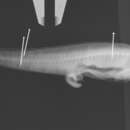Diagnostic Description
provided by Fishbase
Penopus microphthalmus differs from P. japonicus by the following characters: has a higher number of dorsal, 135-158 (vs. 117) and anal, 106-122 (vs. 89) fin rays; lower number of preopercular spines, 4-7 (vs. 9); indistinct spine behind the posterior nostril (vs. distinct, 1% SL); by the bigger horizontal diameter of the eye 1.1-1.6% SL (vs. 0.8); and in having an almost fully scaled head (vs. squamation of the head restricted to the middle part of the preopercle) (Ref. 87601).
- Recorder
- Cristina V. Garilao
Morphology
provided by Fishbase
Dorsal spines (total): 0; Dorsal soft rays (total): 135 - 158; Analspines: 0; Analsoft rays: 106 - 122; Vertebrae: 77 - 83
- Recorder
- Cristina V. Garilao
Biology
provided by Fishbase
Rare species (Ref. 34024). Oviparous, with oval pelagic eggs floating in a gelatinous mass (Ref. 205).
Importance
provided by Fishbase
fisheries: of no interest
Distribution
provided by World Register of Marine Species
the tropical Western Atlantic including the Gulf of Mexico
North-West Atlantic Ocean species (NWARMS)
- license
- cc-by-4.0
- copyright
- WoRMS Editorial Board
Habitat
provided by World Register of Marine Species
depth range 1320 - 3535 m
North-West Atlantic Ocean species (NWARMS)
- license
- cc-by-4.0
- copyright
- WoRMS Editorial Board
Habitat
provided by World Register of Marine Species
nektonic
North-West Atlantic Ocean species (NWARMS)
- license
- cc-by-4.0
- copyright
- WoRMS Editorial Board

